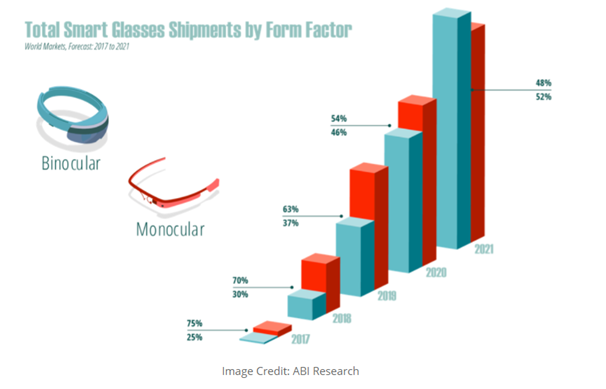
Last Updated on December 30, 2021 by Surender Kumar
Augmented reality smart glasses are wearable devices worn just like spectacles that blend the virtual to the physical data in a user’s view field.
Smart glasses can be categorized into two major types- optical see-through and video see-through. In optical see-through glasses, the user can view directly, while in a video see-through, the user views reality captured by mounted cameras.
Smart glasses allow users to maintain a sense of balance and distinction between the physical and digital realms simultaneously, thereby offering a more natural experience.
Table of Contents
AR Glasses Data Trends:
- The global AR/VR smart glasses market was reported at $8.31 billion in 2019 and is estimated to reach $33.16 billion by 2027, witnessing a CAGR of 16.6% from 2020 to 2027.
- The gaming industry segment held the giant pie with more than two-fifths of the market in 2019 and is expected to lead till 2027.
- The healthcare segment is expected to register the fastest CAGR of 22.5% from 2020 to 2027.
- By region, Asia-Pacific accounted for nearly half of the total market share in 2019. It will show the highest CAGR of 17.9% during the forecast period as per the Allied Markets Report.
Types of AR Glasses:
AR Smart glasses come in two categories- monocular and binocular.
Monocular glasses are smaller and less expensive hence feel less obtrusive. Binocular glasses offer a more immersive experience.

Challenges
The current in-use AR glasses are not visually and functionally appealing, and the cost is a crucial inhibition. The critical challenge for the AR glasses makers is to ensure cost-effective functionality with effortless wearability.
The makers face the task of squeezing innumerable parts and components into a wearable technology that ensures the design, comfort, and inbuilt cooling mechanisms to counter the intense computation, which will pave the way for mass commercial production.
But as the demand for Augmented reality technology and its components grows, the top technology companies like Microsoft, Snap, Apple, Facebook, Google, and even Amazon are innovating to bring out advanced versions.
Some of the recent innovations in the AR smart glasses ecosystem include:
Facebook smartglasses
Facebook is set to launch its Ray-Ban branded AR glasses under Project Aria, in collaboration with luxury eyewear brand Luxottica.
Snap Spectacles AR (4th gen)
The new Snap Spectacles AR runs on the Qualcomm Snapdragon XR1 processor and is currently being offered to developers and Snap creators for further enhancements.
Lenovo Think Reality A3
Lenovo’s smart specs, unveiled in January 2021, are made for day-to-day work, whether that’s in a lab or a shop. It can offer to support up to 5 virtual displays powered by Qualcomm’s Snapdragon XR1 platform to deliver that augmented experience and offer support for working or viewing.
Vuzix Blade Upgraded
The Blade utilizes waveguide technology and is touted as the first pair of commercial AR glasses that look like a pair of glasses and not some technology eyepiece.
Epson Moverio BT 300
The Moverio ensures smooth performance even with content-rich applications, and being compact is comfortable to wear.
HoloLens
The HoloLens is an untethered device that allows users to access the benefits of cloud and AI services from Microsoft—including reliability, security, and scalability.
AR Glasses Use and Applications
Let’s look at some of the most used AR Glasses applications and assess the solutions and experiences they can offer.
Real-Time Solutions
AR smart glasses can assist in enhancing and maintain the efficiency of assembly lines to bring real-time solutions, ensuring just-in-time services, accuracy, and enhanced productivity, which are crucial to manufacturing verticals like aerospace and automotive.
Workplace safety
With the use of smart glasses, workers can have a safe and hands-free work experience. With the help of AR remote assistance, they can get inspections and training done in real-time.
Repair and Maintenance
Augmented reality solutions are proving to be invaluable in the repair and maintenance domain. AR Smart glasses enable workers to receive step-by-step visual prompts to execute the task efficiently and productively.
Visualized Guidance
Remote Video Facility enables experts to see augmented and real-time vision from wherever they are and offer appropriate solutions. This is a boon for many sectors, from engineering to telehealth.
Real-Time Translation.
AR glasses can translate written language allowing for enterprises to function globally without the barriers of languages.
The Future Scope
With tech heavyweights like Apple, Facebook, and others, Samsung is working on mass production of AR-powered smart glasses; it is a matter of time for them to become commercially viable and acceptable.
AR smart glasses have made inroads into many enterprises, and many more innovative businesses are set to join the league of users.
Companies need to assess carefully how new technologies like AR can help them in their business processes. Experts in designing Innovative, Interactive, and Immersive experiences -EDIIIE is one of the largest AR, VR, and MR companies, creating quality and customized solutions for business needs.

I am a passionate blogger having 10 years of experience in blogging and digital marketing. I started List Absolute in 2018 to give my passion a live platform. I have also a good hand in writing unique and quality content. Here I contribute in my free time. Thanks for reading. Let me know if I can help you get your work done in a timely manner.
